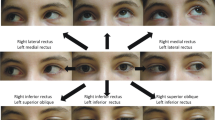Summary
The specificity of adaptation of vestibuloocular reflex direction was examined by exposing cats to combined pitch vestibular rotation and horizontal optokinetic motion at 0.25 Hz, while alternating body position between lying on the left side and lying on the right. The direction of optokinetic motion relative to head motion was reversed when the cat's body posture was changed so that, for example, if head upward rotation was coupled to leftward visual world motion when the cat was lying on its left side, then head upward rotation was coupled to rightward visual world motion when the cat was on its right side. Body position and optokinetic motion direction were changed every 10 min for a total of 2 h of adaptation on each side. Horizontal and vertical electrooculographic recordings were made during pitch rotations in darkness before and after adaptation. Saccades were removed from the records and vestibulo-ocular reflex gain was measured in the direction of optokinetic motion. In every case, the adaptation procedure produced a directional change in the vestibulo-ocular reflex specific to the posture during measurement and appropriate to reduce the retinal image motion caused by the combined vestibular and optokinetic stimuli. That is, adaptive horizontal eye movements measured on the two sides were in opposite directions for the same direction of head motion. This specificity suggests that adaptation of vestibulo-ocular reflex direction involves specific neural pathways that are controlled by body orientation signals which most likely arise from the otolith organs.
Similar content being viewed by others
References
Baker JF, Harrison REW, Isu N, Wickland C, Peterson B (1986) Dynamics of adaptive change in vestibulo-ocular reflex direction. II. Sagittal plane rotations. Brain Res 371: 166–170
Baker JF, Wickland C, Peterson B (1987) Dependence of cat vestibulo-ocular reflex direction adaptation on animal orientation during adaptation and rotation in darkness. Brain Res 408: 339–343
Bond H, Ho P (1970) Solid miniature silver-silver chloride electrodes for chronic implantation. Electroenceph Clin Neurophysiol 28: 206–208
Callan JW, Ebenholtz SM (1982) Directional changes in the vestibular ocular response as a result of adaptation to optical tilt. Vision Res 22: 37–42
Campbell F, Robson J (1968) Application of Fourier analysis to the visibility of gratings. J Physiol 197: 551–566
Collewijn H, Grootendorst A (1979) Adaptation of optokinetic and vestibulo-ocular reflexes to modified visual input in the rabbit. Prog Brain Res 50: 772–781
Collewijn H, Martins A, Steinman R (1983) Compensatory eye movements during active and passive head movements: fast adaptation to changes in visual magnification. J Physiol 340: 259–286
Diamond S, Markham C (1986) Ocular counterrolling examination of benign paroxysmal positional vertigo: is the etiology posterior canal? otolith? or both? Soc Neurosci Abstr 12: 256
Dix M, Hallpike C (1952) The pathology, symptomatology and diagnosis of certain disorders of the vestibular system. Ann Otol Rhinol Laryngol 61: 987–1016
Flock A (1964) Structure of the macula utriculi with special reference to directional interplay of sensory responses as revealed by morphological polarisation. J Cell Biol 22: 413–431
Godaux E, Halleux J, Gobert C (1983) Adaptive change of the vestibulo-ocular reflex in the cat: the effects of a long-term frequency-selective procedure. Exp Brain Res 49: 28–34
Gonshor A, Melvill Jones G (1971) Plasticity in the adult human vestibulo-ocular reflex arc. Proc Can Fed Biol Soc 14: 11
Gonshor A, Melvill Jones G (1976a) Short-term adaptive changes in the human vestibulo-ocular reflex arc. J Physiol 256: 361–379
Gonshor A, Melvill Jones G (1976b) Extreme vestibulo-ocular adaptation induced by prolonged optical reversal of vision. J Physiol 256: 381–414
Harrison R, Baker J, Isu N, Wickland C, Peterson B (1986) Dynamics of adaptive change in vestibulo-ocular reflex direction. I. Rotations in the horizontal plane. Brain Res 371: 162–165
Keller E, Precht W (1979) Adaptive modification of central vestibular neurons in response to visual stimulation through reversing prisms. J Neurophysiol 42: 896–911
Lisberger S, Miles F, Optican L (1983) Frequency-selective adaptation: evidence for channels in the vestibulo-ocular reflex? J Neurosci 3: 1234–1244
Loe P, Tomko D, Werner G (1973) The neural signal of angular head position in primary afferent vestibular nerve axons. J Physiol 320: 29–50
Melvill Jones G, Davies P (1976) Adaptation of cat vestibulo-ocular reflex to 200 days of optically reversed vision. Brain Res 103: 551–554
Miles F, Fuller J (1974) Adaptive plasticity in the vestibulo-ocular responses of the rhesus monkey. Brain Res 80: 512–516
Miles F, Eighmy B (1980) Long-term adaptive changes in primate vestibuloocular reflex. I. Behavioral observations. J Neurophysiol 43: 1406–1425
Pellionisz A (1985) Tensorial aspects of the multidimensional approach to the vestibulo-oculomotor reflex and gaze. In: Berthoz A, Melvill Jones G (eds) Reviews of oculomotor research I. Adaptive mechanisms of gaze control. Elsevier, Amsterdam
Robinson D (1982) The use of matrices in analyzing the threedimensional behavior of the vestibulo-ocular reflex. Biol Cybern 46: 53–66
Schultheis L, Robinson D (1981) Directional plasticity of the vestibulo-ocular reflex in the cat. Ann NY Acad Sci 374: 504–512
Author information
Authors and Affiliations
Rights and permissions
About this article
Cite this article
Baker, J.F., Perlmutter, S.I., Peterson, B.W. et al. Simultaneous opposing adaptive changes in cat vestibulo-ocular reflex direction for two body orientations. Exp Brain Res 69, 220–224 (1987). https://doi.org/10.1007/BF00247045
Received:
Accepted:
Issue Date:
DOI: https://doi.org/10.1007/BF00247045




